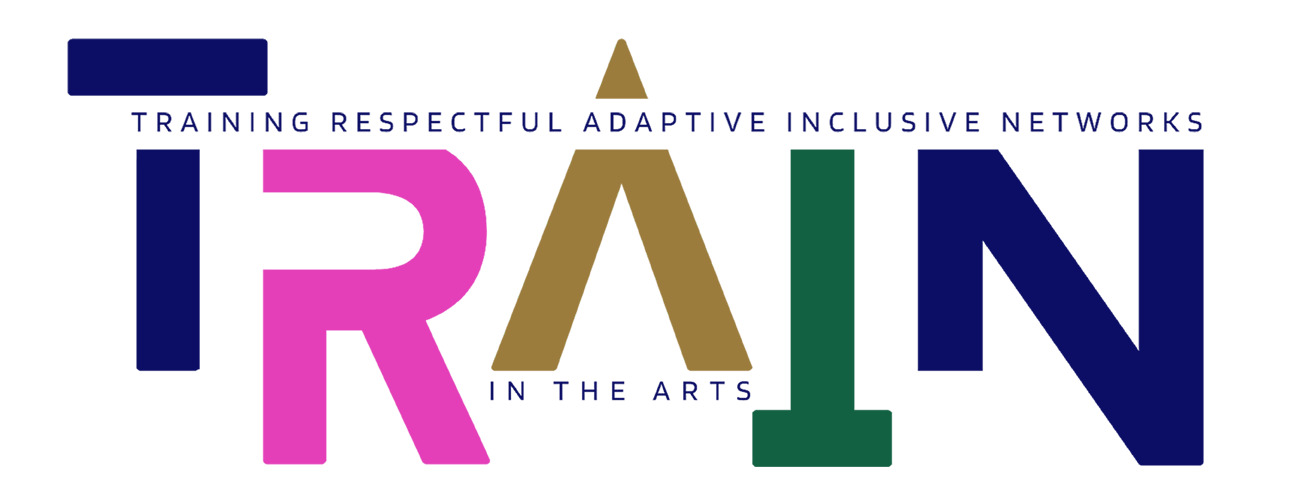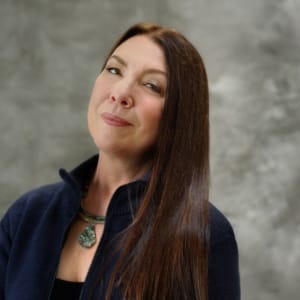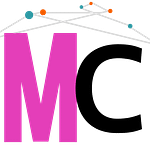
Civic Engagement for Artists
Meet the facilitator
Get to know Rebecca Hass
 Rebecca Hass is a citizen of the Metis Nation and of mixed European descent. As the Director of Engagement Programs and Partnerships for Pacific Opera she was the winner of the Creative Builder for 2021 for Greater Victoria, and the 2019 Arts and Culture award for Community work from Leadership Victoria, specifically for her work in addressing inclusion and diversity. Programming highlights in her work include the development of a civic engagement artist’s residency, a virtual series spotlighting marginalized voices – “For all to hear”, as well as connecting the opera to socially relevant issues through the very successful podcast What’s Up with Opera. Rebecca works with several committees addressing the need for systemic change for Indigenous peoples in art and music, including Canadian Actors Equity Indigenous Committee and Voices in Circle for the University of Victoria. An alumna of the 2019 Opera America Leadership Intensive, Rebecca is a graduate of Wilfrid Laurier University with an Honors Bachelor of Music in Vocal Performance. Her over 30-year career includes a professional opera and concert career as a mezzo soprano and working as a radio broadcaster and documentary maker for CBC radio, as a recurring guest host for Saturday Afternoon at the Opera and In Concert. She is passionate about her work as a mentor to young artists in her work as a Creative Living Coach for the Canadian Opera Company Ensemble and several Canadian universities and elite training programs. Rebecca lives in Victoria, British Columbia (L’ekwungen Territory) where she is an active member of the urban Indigenous community, notably as a director of the drum group ANSWER. Currently she is working on writing songs and stories as part of a multi-media theatrical piece called “Manaadjia” – an Anishinaabemowin word which means “to take care of our people in order to conserve them for a long time”.
Rebecca Hass is a citizen of the Metis Nation and of mixed European descent. As the Director of Engagement Programs and Partnerships for Pacific Opera she was the winner of the Creative Builder for 2021 for Greater Victoria, and the 2019 Arts and Culture award for Community work from Leadership Victoria, specifically for her work in addressing inclusion and diversity. Programming highlights in her work include the development of a civic engagement artist’s residency, a virtual series spotlighting marginalized voices – “For all to hear”, as well as connecting the opera to socially relevant issues through the very successful podcast What’s Up with Opera. Rebecca works with several committees addressing the need for systemic change for Indigenous peoples in art and music, including Canadian Actors Equity Indigenous Committee and Voices in Circle for the University of Victoria. An alumna of the 2019 Opera America Leadership Intensive, Rebecca is a graduate of Wilfrid Laurier University with an Honors Bachelor of Music in Vocal Performance. Her over 30-year career includes a professional opera and concert career as a mezzo soprano and working as a radio broadcaster and documentary maker for CBC radio, as a recurring guest host for Saturday Afternoon at the Opera and In Concert. She is passionate about her work as a mentor to young artists in her work as a Creative Living Coach for the Canadian Opera Company Ensemble and several Canadian universities and elite training programs. Rebecca lives in Victoria, British Columbia (L’ekwungen Territory) where she is an active member of the urban Indigenous community, notably as a director of the drum group ANSWER. Currently she is working on writing songs and stories as part of a multi-media theatrical piece called “Manaadjia” – an Anishinaabemowin word which means “to take care of our people in order to conserve them for a long time”.
Workshops
Summary & Asynchronous Session
Welcome to the resource area for the TRAIN program I created called Artists as Civic Engagers. In this series I wanted to walk fully as a Métis woman carrying my ancestral cultural worldview of what makes good community engagement, and strong leadership, as it applies in my western world career as the Director of Engagement Programs and Partnerships with Pacific Opera. This meant more process, and less product. I invited guests from varied backgrounds with a range of experiences in this space to share their wisdom. My vision for this work was to support artists from varied practices in finding new ways to understand why they do what they do, and how that knowledge can help them be kinder to themselves and more respectful of others as they move forward. There were practical tools shared along the way as well as in invitation to question the way you may have always done things.In the resource package I review each class and offer reflections, slide decks, videos and even a few new exercises that we didn’t get to in our time together.
The whole thing kicked off with a video class that saw me on the land and in my home, sharing knowledge about an Indigenous approach to goal setting as you consider the civic engagement project you will embark on.
Don't let 'how' spoil a good 'what': Class Two with Denise Ball
In our second class, we explored how our bios reflected a western measurement of who we are. Our degrees, and awards listed to impress. Denise Ball, our special guest, took us through examples of different bio and shared exercises meant to allow our full selves to be shared in the stories we tell to represent ourselves.
If you want to learn more about the story you carry about yourself, and consider other stories that are also true, I offer an exercise.
Decolonized leadership model: Class Three with Erin Dixon
This class invited us to see leadership and what it means to be a leader, outside the western model, Métis Erin Dixon, invited to consider the gifts we carry from our ancestors and how those feed our path as leaders. Erin asked us to think about leadership in a relational way, with deep alignment at the front of our work. She encouraged us to start with ourselves, and then move to transform and change those we work with. From the slide deck I have selected a few key slides to support your review of this class. If you are interested in thinking about leadership through an Indigenous lens, you will find powerful prompts in the slide deck. Please consider your relatives and ancestors in this work. Notice the gifts they gave you that you might need to reclaim or reframe. Consider the impact colonization has had on you, and whether you lead from fear or from love?
Review ‘Leadership from inside the circle’ presentation here.
Working with art as a tool: Class Four with Joel Ivany
In class four we were moving from our self examination and self knowledge building into visioning the project. My discussion was with Artistic Director of both Edmonton Opera and Against the Grain Theatre’s Joel Ivany. We discussed the overlap between his civic practice and art making. We also looked at the challenge of life balance when you are immersed in work and the power of saying no. We also looked at when to pull out of a project that isn’t working.If that is something you have struggled with, consider the vision that you began with. Is it being served? What is the impact if you stop the project vs what is the potential harm if you go forward unable to complete as you had visioned? As part of our western approach, we are fired up by goal achieved, regardless of what it might mean to get there, or what might have changed from when you started. Giving yourself permission to change the goal, or to stop the project all together, can reflect the wisdom of considering the impact.
Never walk alone: Class Five with Quodesia Johnon and Grace Sneddon Wong
In class five, I spoke with both Quodesia Johnson and Grace Wong. This class was focused on the importance of deepening relationships with a community that you are engaged with in a project.
Grace asked us to consider deeply the history of the people we engage with so that we can walk with them in a good way.
If you are interested in learning more about relationship building, you can watch the video Grace and I created when she gave me a tour of the Chinatown museum in Victoria. You can also review the slide deck from the class as you consider her question- How do I move from listening and learning to action?
The art of asking for money: Class Six with Yvette Guigeno
Yvette Guigeno, Director of Development for Pacific Opera, shared tips on how artists can feel comfortable asking for money, and the places to look for funding. If you want to learn more about how to get past taking it personally when you get a no when you ask for money, Yvette has tips on slide 6 of the slide deck provided. In the class we talked a lot about how hard it was not to take it personally. My suggestion from my work as a coach for creatives is to find something in your pitch/ story that is very personally relevant to you. Something that you are passionate about, that reflects a deep seated value you have. For example, if I have a project that is taking music to parks, I don’t want to get mired in ‘my idea’ and ‘do you like my idea?’. Thinly veiled feeling of “do you like me?’ Instead, I’m going to focus on what makes this so important to me. The value that this idea is expressing. I’m passionate about barrier free art encounters. I think everyone benefits when they have access to art this way. If I can talk to a donor about what is deeply resonant for me about a project I invite them to get excited about a common value we might both have. Then, if it’s a no for them, I know it isn’t me or the project, but that the value that is being lived in that idea, doesn’t speak to them. They can wish me well, and I can move on to find someone else who believes in this value. It really helps me feel confident in the conversations I’m having, and takes away the personal sting of a ‘no’. It also really invites the big ‘yes’ to show up!
Sharing your success successfully: Class Seven
In the final class, I wanted us to consider the heart of the journey, which was to step away from a Western model and mindset, and consider deeply who we are, and what we value, and what fires us up about the work we engage in with the community.
There are practical elements to visioning a project through to execution and reporting out, but the key for me, is the what. For the sake of what did you embark on this at all? Below are two tools to explore. The first asks you to examine how you approach your projects? Are you fearing failure and trying to get it right as you drive yourself towards a goal that you have been told is the right one, but doesn’t resonate with you?
Using resource slide deck for class seven- slides 1-3
If you want to embrace a new frame for your work, I suggest you start with looking at the western model of goal setting, and compare it to the one shared with me by an Anishinaabe Elder. Consider how the view is different, and also the feeling of these two approaches. How do directions like “realistic” and “timely” make your gut feel? Compared to “perseverance” and “movement” . Imagine setting in motion a project/vision/goal and moving forward through the Western SMART model. Notice the inside dialogue that it sparks. Write it down as a reflection. Now imagine moving through a project using the Indigenous circle for vision. What inside dialogue is sparked by this path? Write it down as a reflection.
Get curious about how ‘goal achieved’ serves empowers or doesn’t versus ‘movement’ . What are the differences? What things might be the same?
If you want to delve more deeply into your ‘what’, start with the Wheel of Life. A classic life coaching tool that I have reworked to speak to artists engaged in civic spaces in this moment in time. Use resource slide deck for class seven-slides: 4 to 7
Draw a circle and divide it into 8 wedges, label each wedge with one of the following
- People
- Community
- Where I am
- Creative Expression
- Caring for self
- Personal Growth
- Money
- Career resonance
Consider the wedges, with the following prompts for reflection.
- Inside each of these what are a few words, or examples of what fulfills you in this area. What do you value in this space? For example: People: close friends, partner
- Rate satisfaction of each of these in your life today. i.e. People : about a 7. I’m working a lot and not seeing them as much as I want.
- Inside each of these, if this was a ten, if it was how you wanted it, what would be happening, who is there, what would be really working? i.e If it was a ten, I’d host a bbq in the backyard that my partner and I organized with a badminton game.
- What are small steps you can make toward this, so you can make the 7 and 8 or 9 in satisfaction?
Low bar: I play around with a menu I’d love to serve them.
Mid bar: I invite us all to get together at a local burger joint for dinner.
High bar: I set a date and invite them all to come in the next three months.
- Looking at the list of all 8, regardless of the score, to feel balanced and fulfilled what are your top three? If these have high scores, you probably feel pretty balanced. If they don’t, you are likely feeling that things are out of balance. We don’t need these all to be tens, we need the ones we care about to score highly. If a top three is personal growth and it scores a 4, you likely want to consider how to support that more. Look back at the suggestions of low, mid and high bar change. Make a plan. Just thinking about change counts as a step towards change. Be kind to yourself. Small steps count.
- If what you value is missing in the list, write it in. This is your recipe for a good life.
Each wedge holds what most of us would say are part of the values lived in a good life. But which value, and how it is defined, is very personal. For some, spending time with friends is a party on a beach, for others it’s one other person over a long lunch. The better you know what fulfills you, the better you will be at feeling balanced. You will also be better at finding your fuel for everything in your life,Including the kinds of civic engagement projects you want to take part in, and the communities you want to work with. Your values can be expressed in many ways, and knowing what’s at the core, can really give you freedom in how you express it. For me, I used to think I needed to sing to be a fully expressed artist. But the core value for me isn’t singing, singing is a way I express my need to tell stories and connect with people in a meaningful way.
Look at the list of values, can you see what your art helps you live? What helps you express? What core values are living in your work or your art?
Exercise:
Write your top three values on a post it note. Put it on your bathroom mirror. At the end of every day, ask yourself, did I live this today? If not, look at how you include it in your tomorrow.
T.R.A.I.N was made possible by the Government of Canada through the Canadian Heritage Performing Arts Workers Resilience Fund.
Workshops took place September 2022 – March 2023, live and asynchronous, and delivered in English, French, and ASL and were free to join.


